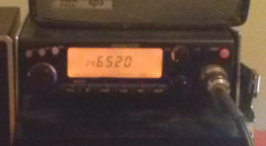Kenwood TM-241A: Difference between revisions
Jump to navigation
Jump to search
Created page with " == Programming == # Press the VFM/M>V key to select the VFO operating mode # Select the frequency, tone, offset # Press the F key. The F indicator and a channel memory nu..." |
mNo edit summary |
||
| (5 intermediate revisions by 2 users not shown) | |||
| Line 1: | Line 1: | ||
A 2-meter amateur radio band transceiver with CTCSS Encode, Auto Repeater Offset, and 20 Memories. The TM-241A transmits on 2 meters with three output power levels: 5/10/50 watts. Extended receive allows reception from 118 to 174 MHz. | |||
[[File:kenwood-tm-241a.jpg]] | |||
*Frequency Range TX: 144 - 148 MHz | |||
*RX: 118 - 174 MHz | |||
*RF Output Power HI 50 W | |||
*RF Output Power MID 10 W | |||
*RF Output Power LO 5 W | |||
*Power Requirement 13.8V DC (±15%) | |||
*Current Drain Receive Less than 600 mA | |||
*Current Drain Transmit Less than 11 Amps | |||
*Microphone Impedance 500-600 ohms | |||
*Antenna Impedance 50 ohms | |||
*Dimensions (W x H x D) 5.51 x 6.3 x 1.57 in. (140 x 40 x 160 mm) | |||
*Weight (approx.) 2.4 lbs. (1.1 kg) | |||
== VFO Control == | |||
=== Select CTCSS Tone === | |||
# Long-press the F key. The F indicator will flash. | |||
# Press the TONE/T.ALT button | |||
# Turn dial to select PL tone. | |||
# Once correct tone selected, short-press F key to accept. | |||
== Programming == | == Programming == | ||
# Press the | # Press the [VFO] key to select the VFO operating mode | ||
# Select the frequency, tone, offset | # Select the frequency, tone, offset | ||
# Press the F key. The F indicator and a channel memory number will be displayed. | # Press the [F] key. The [F] indicator and a channel memory number will be displayed. | ||
# Select the memory channel to store the frequency in. | # Select the memory channel to store the frequency in. | ||
# Press the MR/M button within 10 seconds. If you hear a long beep, and the F indicator and channel indicator go away then the program was successful. | # Press the [MR/M] button within 10 seconds. If you hear a long beep, and the F indicator and channel indicator go away then the program was successful. | ||
==related models== | |||
The Kenwood TM-441A transmits on 440 MHz with three output power levels: 5/10/35 watts. | |||
The Kenwood TM-541A transmits on 1200 MHz with 1/10 watts. | |||
[[Category:Electronics]] | |||
[[Category:Radio]] | |||
[[Category:Ham Radio]] | |||
[[Category:2-Way Radio]] | |||
[[Category:Tangible Product]] | |||
[[Category:Transceiver]] | |||
Latest revision as of 12:41, 1 February 2019
A 2-meter amateur radio band transceiver with CTCSS Encode, Auto Repeater Offset, and 20 Memories. The TM-241A transmits on 2 meters with three output power levels: 5/10/50 watts. Extended receive allows reception from 118 to 174 MHz.
- Frequency Range TX: 144 - 148 MHz
- RX: 118 - 174 MHz
- RF Output Power HI 50 W
- RF Output Power MID 10 W
- RF Output Power LO 5 W
- Power Requirement 13.8V DC (±15%)
- Current Drain Receive Less than 600 mA
- Current Drain Transmit Less than 11 Amps
- Microphone Impedance 500-600 ohms
- Antenna Impedance 50 ohms
- Dimensions (W x H x D) 5.51 x 6.3 x 1.57 in. (140 x 40 x 160 mm)
- Weight (approx.) 2.4 lbs. (1.1 kg)
VFO Control
Select CTCSS Tone
- Long-press the F key. The F indicator will flash.
- Press the TONE/T.ALT button
- Turn dial to select PL tone.
- Once correct tone selected, short-press F key to accept.
Programming
- Press the [VFO] key to select the VFO operating mode
- Select the frequency, tone, offset
- Press the [F] key. The [F] indicator and a channel memory number will be displayed.
- Select the memory channel to store the frequency in.
- Press the [MR/M] button within 10 seconds. If you hear a long beep, and the F indicator and channel indicator go away then the program was successful.
The Kenwood TM-441A transmits on 440 MHz with three output power levels: 5/10/35 watts.
The Kenwood TM-541A transmits on 1200 MHz with 1/10 watts.
